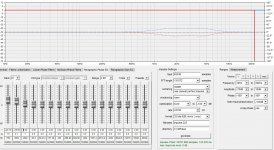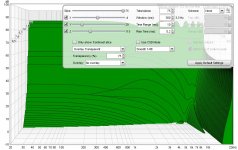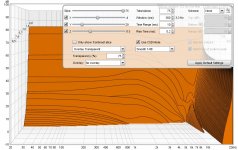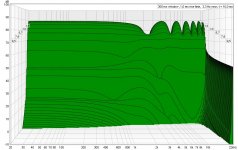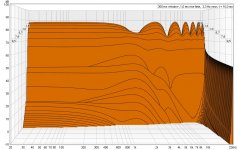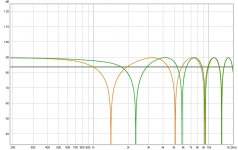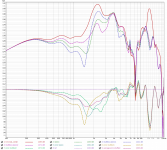Right, I forgot to add the bandpass.
I was playing around with using the decorrelator with my active matrix upmixer yesterday and interestingly, though my initial impression was positive, it actually doesn't seem to be an improvement overall. I figured that since the surrounds are sometimes partially correlated (depending on the steering and correlation of the inputs), adding additional decorrelation would be a good thing. Overall, it sounds slightly "bigger" with the decorrelator, but less clear.
I was playing around with using the decorrelator with my active matrix upmixer yesterday and interestingly, though my initial impression was positive, it actually doesn't seem to be an improvement overall. I figured that since the surrounds are sometimes partially correlated (depending on the steering and correlation of the inputs), adding additional decorrelation would be a good thing. Overall, it sounds slightly "bigger" with the decorrelator, but less clear.
Too bad it didn't do any good in your case. If your implementation is true to Logic 7 I'd half expect the decorrelation to be part of the complete set of rules it was made of?
As that is high on the lists of Griesinger for ambient sounds to work well. While I could understand if some parts were meant to actually have some relationship (coherently) with the front signals to be able to move them where they wanted them.
I'd be curious about timing of the ambient vs mains in these pieces of software. This is more than just a late Haas kicker (at say 15-25 ms)
As that is high on the lists of Griesinger for ambient sounds to work well. While I could understand if some parts were meant to actually have some relationship (coherently) with the front signals to be able to move them where they wanted them.
I'd be curious about timing of the ambient vs mains in these pieces of software. This is more than just a late Haas kicker (at say 15-25 ms)
On average, the correlation between the surround channels is pretty low, but it isn't zero unless the inputs have zero correlation. My conjecture at the moment is that correlated sounds are more easily ignored due to auditory masking since they are more similar to the sound from the main speakers. So when you add additional decorrelation, the sounds that were correlated become easier to detect.
Regarding timing/delay, Griesinger's patents mention 10-15ms delay for the side surrounds in 5-channel systems and an additional 10ms or so for rear surrounds in 7-channel systems.
Personally, I've been using about 17ms for my side surrounds. I've also been experimenting with using allpass filters to increase the delay at LF while keeping the HF delay the same (haven't yet decided whether this is actually a good idea...).
Regarding timing/delay, Griesinger's patents mention 10-15ms delay for the side surrounds in 5-channel systems and an additional 10ms or so for rear surrounds in 7-channel systems.
Personally, I've been using about 17ms for my side surrounds. I've also been experimenting with using allpass filters to increase the delay at LF while keeping the HF delay the same (haven't yet decided whether this is actually a good idea...).
Last edited:
Thanks for the info on configuring the srround channels. What kind of bandpass are both of you using?
One thing you might try, bmc and Wesayso, is a 45 deg phase delta between L and R from about 800 hz to 10 kHz. It does wonders to spaciousness and realism.
One thing you might try, bmc and Wesayso, is a 45 deg phase delta between L and R from about 800 hz to 10 kHz. It does wonders to spaciousness and realism.
Last edited:
My surrounds currently have a second order highpass at 100Hz (set by a Linkwitz transform) and a first order lowpass at 6kHz. Dr. Griesinger recommends having side surrounds that go down to 40Hz, but mine don't have the volume displacement capability for that.
150-3500 for the L-R (second order) and 150-5500 for the mixed in L+R in my case.
Would love to try and go lower, but the speakers won't allow it. Plus I'd think the interference with mains could start to play a role.
I have tried phase angles in mains, but while it did work in the sweet spot, it degraded performance in adjacent seats for me. My goals still are an excellent sweet spot with good wider area performance to accommodate my family members. Heck, with movies I don't always get the price seat as my son has found its merits.
Would love to try and go lower, but the speakers won't allow it. Plus I'd think the interference with mains could start to play a role.
I have tried phase angles in mains, but while it did work in the sweet spot, it degraded performance in adjacent seats for me. My goals still are an excellent sweet spot with good wider area performance to accommodate my family members. Heck, with movies I don't always get the price seat as my son has found its merits.
Thanks both! I would've expected some kind of shelving earlier, maybe around 1 kHz so as to make it harder to localize. I don't have it setup at the moment, but will give it a try.
The 45 deg delta trick works really well with horns or more directional speakers. With the line arrays, it definitely improves things. Doesn't seem to be too bad across the couch, but then the couch is quite far from the arrays.
The 45 deg delta trick works really well with horns or more directional speakers. With the line arrays, it definitely improves things. Doesn't seem to be too bad across the couch, but then the couch is quite far from the arrays.
I had to see if ra7's version of a crosstalk phase scrambler did any different from my earlier experiments...
So I created the RePhase impulses with about a 22.5 degree difference:

And in REW I tried to sum them as I did with my previous attempt, where I found the explanation of why it seemed to favor one side over the other.
The simple sum (actual results at the ear would be far more complex):

Here is the sum at the ear after a millisecond has passed:

And here's the other ear:

The biggest difference is happening before enough time has passed to hear the other speaker:

vs:

There is a balance difference between these two, in other words, before the cross talk has (normally) taken place. What do i mean by that? Due to the phase angle difference, one speaker is playing a bit before the other (over the changed phase range) and thus, is showing up in the signal at one ear, prior to where the sound of the further speaker reaches our ear. That's a very brief moment (0.27 ms was taken as the average delay here).
I'll have to look back at my own tries, if I had troubles before the cross talk time had passed or that my troubles were from an imbalance after the cross talk. The way I see it here, this could work! Yes, you would have the signal from one speaker just ahead of the other in the affected range, but it is so minimal. And it happens at a point where phase isn't used for identifying image queues. Intensity is, so would that slight imbalance in the first few ms be enough to upset anything? Even after that full millisecond, there still is a slight SPL difference in both results, but that could be EQ-ed away.
In the first ~3ms, the imbalance is the difference between 83.5 and 89.5 dB.
The average "in head" balance with this phase tweak at the sweetspot will be better than not doing anything at all.
I should try and process off axis seats the same way to see what happens there. That would tell me if this favors one listening side over the other, in a similar way I had it happen to me in earlier tries. It would only be audible with enough absence of early room reflections though. I was rather critical about it.
But the thing is, I first heard, out in the room listening to music, there was an imbalance, even before I went looking at the plots to prove it. I have lived with it for a couple of weeks before I abandoned that solution. For that reason I have thought long and hard about an alternating shuffler 😀. Alternating between the channels as not to favor one side.
P.S. that use CSD mode that I accidentally clicked on one graph had no effect. Clearly one side is a little ahead over the other which is due to their phase difference. That means it sums a little earlier than the other side.
So I created the RePhase impulses with about a 22.5 degree difference:
And in REW I tried to sum them as I did with my previous attempt, where I found the explanation of why it seemed to favor one side over the other.
The simple sum (actual results at the ear would be far more complex):
Here is the sum at the ear after a millisecond has passed:
And here's the other ear:
The biggest difference is happening before enough time has passed to hear the other speaker:
vs:
There is a balance difference between these two, in other words, before the cross talk has (normally) taken place. What do i mean by that? Due to the phase angle difference, one speaker is playing a bit before the other (over the changed phase range) and thus, is showing up in the signal at one ear, prior to where the sound of the further speaker reaches our ear. That's a very brief moment (0.27 ms was taken as the average delay here).
I'll have to look back at my own tries, if I had troubles before the cross talk time had passed or that my troubles were from an imbalance after the cross talk. The way I see it here, this could work! Yes, you would have the signal from one speaker just ahead of the other in the affected range, but it is so minimal. And it happens at a point where phase isn't used for identifying image queues. Intensity is, so would that slight imbalance in the first few ms be enough to upset anything? Even after that full millisecond, there still is a slight SPL difference in both results, but that could be EQ-ed away.
In the first ~3ms, the imbalance is the difference between 83.5 and 89.5 dB.
The average "in head" balance with this phase tweak at the sweetspot will be better than not doing anything at all.
I should try and process off axis seats the same way to see what happens there. That would tell me if this favors one listening side over the other, in a similar way I had it happen to me in earlier tries. It would only be audible with enough absence of early room reflections though. I was rather critical about it.
But the thing is, I first heard, out in the room listening to music, there was an imbalance, even before I went looking at the plots to prove it. I have lived with it for a couple of weeks before I abandoned that solution. For that reason I have thought long and hard about an alternating shuffler 😀. Alternating between the channels as not to favor one side.
P.S. that use CSD mode that I accidentally clicked on one graph had no effect. Clearly one side is a little ahead over the other which is due to their phase difference. That means it sums a little earlier than the other side.
Attachments
Last edited:
wesayso, Your web pages are expertly presented and the detail is awesome. You have put an incredible amount of work into the product and the presentation of your journey. The result in your home is nothing less than astounding. I wish that I could sit in the sweet spot and listen to my favorite music.
Hi Eddie, thanks for the compliment! Much appreciated!
Ronald
P.S. I should work on it to get all info up there that I wanted to... Right now I'm just too busy in my head trying to come up with a game plan to get back up and running asap. I'm going over a lot of old stuff I've written to remember the most successful things I've done so far. Yet, a new series of experiments is waiting for me due to what bmc0 triggered. 🙂
Some day I hope to finish what I started there. Even if it's only to clear my head and make me remember it all...
Ronald
P.S. I should work on it to get all info up there that I wanted to... Right now I'm just too busy in my head trying to come up with a game plan to get back up and running asap. I'm going over a lot of old stuff I've written to remember the most successful things I've done so far. Yet, a new series of experiments is waiting for me due to what bmc0 triggered. 🙂
Some day I hope to finish what I started there. Even if it's only to clear my head and make me remember it all...
Last edited:
What if simply move to one side a little? Does that affect the imbalance? Does the rest of the spectrum shift?
From past experience I would say the phase only trick favors one side. Move to the other side a little and you'll notice the imbalance. However, this was with a slightly different phase trick than ra7 uses, but overall pretty similar.
I've had it for weeks, maybe months before I decided against it. Something was off in listening, especially right next to the sweet spot. Due to being able to choose which side I've ran it to favor the 2 most used seats for a while. But this is my experience in my setup/room. Ra7 reported about this in May this year (?), so he's probably more satisfied with it than I was. At times I'm just overly critical. 😉
I've had it for weeks, maybe months before I decided against it. Something was off in listening, especially right next to the sweet spot. Due to being able to choose which side I've ran it to favor the 2 most used seats for a while. But this is my experience in my setup/room. Ra7 reported about this in May this year (?), so he's probably more satisfied with it than I was. At times I'm just overly critical. 😉
The simple sum (actual results at the ear would be far more complex)
Here are the magnitude responses I got using MIT's anechoic KEMAR data:
Attachments
Based on the graph from bmc0, the dip at ~1750 is the biggest deviation, the shuffler shaves off an average of 4 dB. But around 5.5 KHz the differences are small, maybe even small enough to neglect the correction running all the way up there? So making it work on a shorter range might work just as well.
I didn't expect that big of a difference at 13.5 KHz though. I had assumed head shading would be effective enough for it not to matter as much.
I still can't quite grasp the sum I get in REW before enough time has passed to have cross talk in a normal situation. It seems like the phase tweak moves one entire channel up in time, and slows down the other, instead of restricting it to the targeted area. How else do I get such a sum like that over that wide of an area. That sum is making the level difference between both channels stand out.
I didn't expect that big of a difference at 13.5 KHz though. I had assumed head shading would be effective enough for it not to matter as much.
I still can't quite grasp the sum I get in REW before enough time has passed to have cross talk in a normal situation. It seems like the phase tweak moves one entire channel up in time, and slows down the other, instead of restricting it to the targeted area. How else do I get such a sum like that over that wide of an area. That sum is making the level difference between both channels stand out.
Last edited:
The feeling I get when listening to the 45 deg delta is that it becomes easier to localize instruments and really feel like you are in the recording space. Just somehow helps the brain process the sounds better. I'm really curious about how it is perceived when you get a chance to hear it.
I do know what you've been experiencing, as I've certainly been there 🙂.
It is why I've done countless experiments and lots varieties based on the same goal; filling up the simultaneous hole at the pair of ears we have. It is worth it to find something that works. While I haven't used the exact same phase deviation, I've been quite close to it (I just had a dip to zero at peak positions, between ~1.8 and 5.5 KHz)
I've also tried to fill it with counter signals, like done in Ambiophonics and other cross talk compensation routines.
It is why I've done countless experiments and lots varieties based on the same goal; filling up the simultaneous hole at the pair of ears we have. It is worth it to find something that works. While I haven't used the exact same phase deviation, I've been quite close to it (I just had a dip to zero at peak positions, between ~1.8 and 5.5 KHz)
I've also tried to fill it with counter signals, like done in Ambiophonics and other cross talk compensation routines.
How is the home renovation coming along?
I’ve pretty much copied your work on the s-curve, which makes a huge difference also. Haven’t tried ambiophonics.
I’ve pretty much copied your work on the s-curve, which makes a huge difference also. Haven’t tried ambiophonics.
The home is about ready, I hope to return to speaker work this weekend. Still lots to do and packages coming in with materials I need (like neoprene washers M6 etc.).
Original plan was to give them a fresh coat of epoxy and paint, but for that to happen I need temps of 15 degree Celsius. Which I can actually reach this weekend, but after that temperatures will drop again fast. Between Christmas and New Years I have a couple of days off, but then the temperatures will probably be too low.
Last year I epoxied and painted my subwoofers in December. No such luck this year I guess, as I had too much other stuff around the house that needed to be done.
Always running out of time, or so it seems. So the new plan is to upgrade the speakers (adding the filters) and get them inside again. I'll do the epoxy + paint at a later date somewhere in the spring season.
I've been without arrays for about 5 months now, it feels like forever!
Original plan was to give them a fresh coat of epoxy and paint, but for that to happen I need temps of 15 degree Celsius. Which I can actually reach this weekend, but after that temperatures will drop again fast. Between Christmas and New Years I have a couple of days off, but then the temperatures will probably be too low.
Last year I epoxied and painted my subwoofers in December. No such luck this year I guess, as I had too much other stuff around the house that needed to be done.
Always running out of time, or so it seems. So the new plan is to upgrade the speakers (adding the filters) and get them inside again. I'll do the epoxy + paint at a later date somewhere in the spring season.
I've been without arrays for about 5 months now, it feels like forever!
Taking advantage of the higher temperatures I've moved forward just a little with sealing strip application etc to seal up the first array. Not nearly done yet. The butyl rope gets everywhere so I decided to re-arrange the construction a bit so they don't clog up the bolts upon disassembly. The original seals on the front of the TC9's were among the victims of the butyl rope's stickiness. So that needs replacing too. I got some neoprene sheets in 1mm thickness that will do the job. Still using the butyl though. As I haven't found anything else that can compare/compete in what it does.
It ends up being a lot of work, I do realize that. But how often do they come apart?
Don't answer that 😀. The filters simply must work well!
I'm also counting on our room renovation not to mess up things too much. The biggest changes are a 20 cm higher ceiling (no longer made of rattling aluminium) and a different curtain material.
It ends up being a lot of work, I do realize that. But how often do they come apart?
Don't answer that 😀. The filters simply must work well!
I'm also counting on our room renovation not to mess up things too much. The biggest changes are a 20 cm higher ceiling (no longer made of rattling aluminium) and a different curtain material.
Last edited:
This powered column PA system may have been posted before in this thread.
It's quite a remarkable product for a manufacturer of low budget PA equipment. Not exactly cheap either - about € 4000 each,
but for that you get a line source designed by Porsche and at least 2 x 10" PHL woofers (also used by Genelec and Neumann).
From the brochure:
Incorporating LD Systems® WaveAhead® tweeter arrangement technology, the innovative SonicGuide® plays a major
role in the MAUI® P900’s outstanding audio performance. The patented design merges the midrange and high frequency
transducers’ signals to a coherent plane wavefront that is perfectly phase and time aligned.
It's quite a remarkable product for a manufacturer of low budget PA equipment. Not exactly cheap either - about € 4000 each,
but for that you get a line source designed by Porsche and at least 2 x 10" PHL woofers (also used by Genelec and Neumann).
From the brochure:
Incorporating LD Systems® WaveAhead® tweeter arrangement technology, the innovative SonicGuide® plays a major
role in the MAUI® P900’s outstanding audio performance. The patented design merges the midrange and high frequency
transducers’ signals to a coherent plane wavefront that is perfectly phase and time aligned.
Attachments
-
 c59d8a_d8427eafaee1497d9923366a2d849e48_mv2_d_3000_3000_s_4_2.jpg168.9 KB · Views: 136
c59d8a_d8427eafaee1497d9923366a2d849e48_mv2_d_3000_3000_s_4_2.jpg168.9 KB · Views: 136 -
 c59d8a_e6b96b7ed30b43909bba9bc4ac750cde_mv2_d_3000_1688_s_2.jpg170.7 KB · Views: 496
c59d8a_e6b96b7ed30b43909bba9bc4ac750cde_mv2_d_3000_1688_s_2.jpg170.7 KB · Views: 496 -
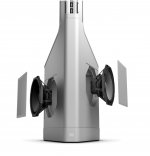 c59d8a_966217642e814ee3963a1141d9b1c5a7_mv2.jpg276.3 KB · Views: 149
c59d8a_966217642e814ee3963a1141d9b1c5a7_mv2.jpg276.3 KB · Views: 149 -
 c59d8a_9f14c2251b5f432fb82a41235d750ac8_mv2_d_3000_2250_s_2.jpg236.9 KB · Views: 242
c59d8a_9f14c2251b5f432fb82a41235d750ac8_mv2_d_3000_2250_s_2.jpg236.9 KB · Views: 242 -
 c59d8a_3c1099d2b9274c3db94d59b99b04a371_mv2.png18.9 KB · Views: 253
c59d8a_3c1099d2b9274c3db94d59b99b04a371_mv2.png18.9 KB · Views: 253 -
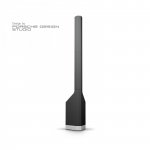 c59d8a_5999cf9256ce44d99209f60a4dfa72d6_mv2_d_3000_3000_s_4_2.jpg221.5 KB · Views: 243
c59d8a_5999cf9256ce44d99209f60a4dfa72d6_mv2_d_3000_3000_s_4_2.jpg221.5 KB · Views: 243 -
 Specs MAUI_P900.png832 KB · Views: 127
Specs MAUI_P900.png832 KB · Views: 127
Last edited:
- Home
- Loudspeakers
- Full Range
- The making of: The Two Towers (a 25 driver Full Range line array)
